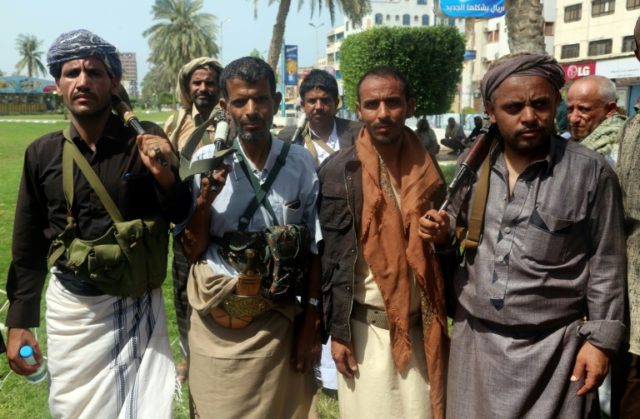The internationally recognized government of Yemen and Iran-allied Houthi rebels agreed over the weekend to start pulling out their forces from the strategically important port city of Hodeidah under a United Nations-sponsored deal, negotiators from the international body announced on Sunday.
The deal broke as reports surfaced that the Shiite Houthi forces had seized more territory inside Saudi Arabia.
Since March 2015, a Saudi Arabia-led Sunni coalition of mainly Gulf countries has been fighting Shiite Iran-backed Houthi rebels to restore the government of Yemeni President Abd Rabbu Mansour Hadi.
In December, the warring parties reached a truce in Hodeidah that largely held until confrontations reportedly increased in recent weeks.
Under the fragile ceasefire, the two sides agreed to withdraw troops from Hodeidah by January 7, to no avail. However, a spokesman for the U.N. declares in a February 17 statement, “After lengthy but constructive discussions [over the weekend] facilitated by [a U.N.-brokered panel], the parties reached an agreement on Phase 1 of the mutual redeployment of forces.”
The spokesman does not elaborate further on what was agreed.
“Under phase 1, forces from both sides will withdraw from the ports of Hodeidah, Saleef, and Ras Issa,” Voice of America (VOA) explains.
The warring parties also agreed “in principle” on Phase 2, which refers to the full redeployment of all fighters in Hodeidah province, the U.N. statement reveals.
Reuters learned from two anonymous sources involved in the negotiations that “both sides had yet to agree on a withdrawal timeline or on a mechanism for local forces to take over security at the ports and city.”
Houthi rebels capturing territory inside southern Saudi Arabia over the weekend could potentially derail the withdrawal deal, which would allow the U.N. to access much-needed food for millions of hungry Yemenis.
Citing the Houthi-ran Saba news agency, Middle East Monitor (MEMO) notes:
Yemen’s Houthi group yesterday announced that it had taken control over a number of sites inside the Saudi territory.
Pro-Houthi SABA reported that the group’s “army forces and popular committees repulsed several attempts by the locals and the Saudi forces to restore the seized sites in Jazan, Najran and Asir region.”
On Saturday, the Saudi military reportedly confirmed that deadly clashes with the Houthis that killed nine of its soldiers along the Yemeni-Saudi border.
Northern Yemen borders southern Saudi Arabia.
Citing the U.S.-based Institute for Near East Policy, MEMO reported in January 2018 that Houthis control 100 miles of Saudi Arabia’s southern territory.
Iran-allied Houthis control most of northern Yemen, including the capital Sanaa and Hodeidah, considered the lifeline of the country as the largest and most vital port where most of the aid and food comes through.
Yemen, the most impoverished country in the Middle East, heavily relies on imports for almost 90 percent of its food and the vast majority of aid.
For about a year, the Saudi-led coalition has been trying to push the Houthis out of Hodeidah, as having access to a port also allows Iranian military supplies and funding to reach the rebels.
Echoing other aid groups, the U.N. warned that an all-out battle for the port could escalate what has already been dubbed the world’s worst humanitarian crisis, choking off the delivery of urgently needed assistance and triggering a famine that would imperil millions of lives.
The U.N. Security Council has reportedly been pushing for the withdrawal of fighters from the port city, the stabilization of the fragile ceasefire, and access to tons of food needed to feed the estimated 20 million Yemenis facing starvation.
Last week, the U.N. said the fighting in Hodeidah is preventing aid workers from accessing over 50,000 tons of World Food Program grain “at risk of rotting” while millions of Yemenis find themselves on the brink of starvation.
An unnamed U.N. sourced indicated to Reuters that under the first phase of the withdrawal agreement, that two sides agreed “to enable access to Red Sea Mills,” which holds the at-risk grains, considered enough to feed 3.7 million people for a month.
They also “agreed to reopen main roads linking Hodeidah to the Houthi-held capital Sanaa and in Yemen’s third city of Taiz,” the source added.

COMMENTS
Please let us know if you're having issues with commenting.